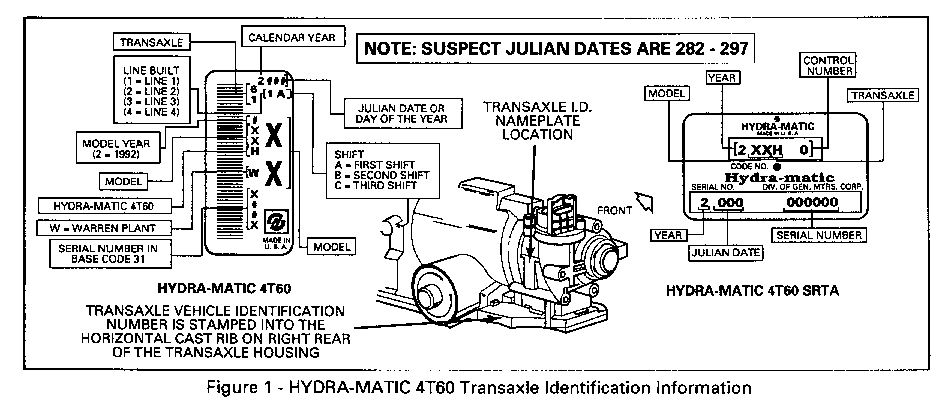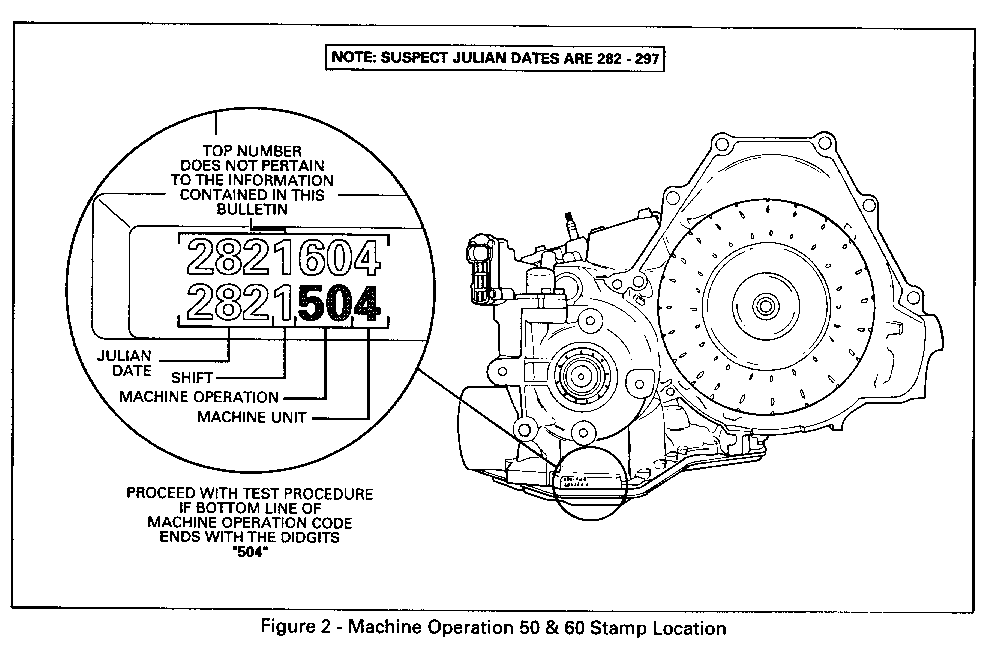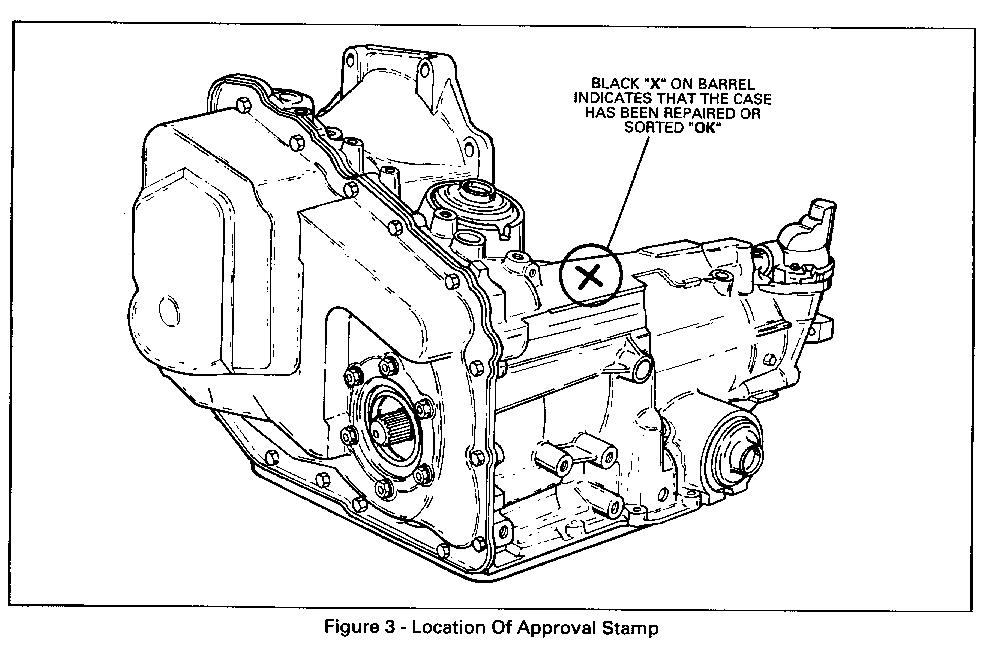CAMPAIGN: NO REVERSE/BAND DRAG REVERSE MOVEMENT IN NEUTRAL

Subject: PRODUCT SAFETY CAMPAIGN 92-C-07 NO REVERSE, REVERSE BAND DRAG IN DRIVE RANGE, OR VEHICLE MOVEMENT IN REVERSE WHILE IN NEUTRAL
Models Affected: 1992 GRAND PRIX MODEL VEHICLES EQUIPPED WITH HYDRA-MATIC 4T60 (RPO ME9)
The National Traffic and Motor Vehicle Safety Act, as amended, provides that each vehicle which is subject to a recall campaign of this type must be adequately repaired within a reasonable time after the owner has tendered it for repair. A failure to adequately repair within sixty (60) days after tender of a vehicle is prima facie evidence of failure to repair within a reasonable time.
If the condition is not adequately repaired within a reasonable time, the owner may be entitled to an identical or reasonably equivalent vehicle at no charge or to a refund of the purchase price less a reasonable allowance for depreciation.
To avoid having to provide these burdensome solutions, every effort must be made to promptly schedule an appointment with each owner and to repair their vehicle as soon as possible. As you will see in reading the attached copy of the letter that is being sent to owners, the owners are being instructed to contact the Pontiac Customer Assistance Center if their dealer does not remedy the condition within five (5) days of the mutually agreed upon service. date. If the condition is not remedied within a reasonable time, they are instructed on how to contact the National Highway Traffic Safety Administration.
CONDITION
General Motors has determined that a defect which relates to motor vehicle safety exist in certain 1992 Grand Prix model vehicles equipped with four-speed automatic transaxles. The reverse servo apply pin may bind in the case which could cause reverse band distress, (loss or slipping of reverse), reverse band drag in drive range (poor performance/low power), or the vehicle to remain in reverse while the shift indicator shows neutral gear position. If the vehicle remains in reverse while the shift indicator shows neutral, and the driver does not apply the brake, the vehicle may unexpectedly move rearward and cause an accident without prior warning.
DEALER ACTION
To prevent this condition from occurring, dealers are to inspect involved vehicles; then if necessary, test involved vehicles; and finally replace transaxles as required. DCS message PC14, dated November 14, 1991 was sent to all Pontiac dealers with instructions to hold all unsold suspect vehicles until further notice was received. All unsold suspect vehicles MUST be held at dealers and inspected/repaired per the campaign Service Procedure BEFORE owners take possession of these vehicles. Completion of this campaign lifts hold on unsold vehicles in the DCS message.
OWNER NOTIFICATION
Owners will be notified of this campaign on their vehicles by Pontiac Division (see copy of owner letter included with this bulletin).
VEHICLES INVOLVED
Involved are CERTAIN 1992 Grand Prix model vehicles built with the 4T60 transaxle with transaxle Julian date codes 282 through and including 297 with case machine operation number 50 and machine unit number 4 (see Figure 2), within the following VIN breakpoints:
VIN Transaxle Engine Transaxle Transaxle Julian Up To And Code Type (RPO) Code Date Beginning Including ----- ---- ---------- --------- --------- --------- T 4T60 ME9 282 - 297 NF228297 NF228941 T 4T60 ME9 282 - 297 NF230675 NF233400
While all vehicles involved will require an inspection of the transaxle ID plate for Julian date, and case for machine unit stamp verification, it is expected that only about 7% of the inspected vehicles will require a transaxle exchange.
Some of the subject vehicles within the breakpoints listed above were corrected at the factory prior to being shipped and will not require inspection by the dealer. Factory corrected transaxles can be identified by a BLACK "X" marked on the barrel of the case as shown in Figure 3. All subject vehicles which are listed on the dealers' campaign printout will require inspection (and as necessary, further action) as outlined in the SERVICE PROCEDURE section of this bulletin. Other suspect vehicles should be checked for campaign involvement by utilizing the Vehicle Information Service System (VISS).
Involved vehicles have been identified by Vehicle Identification Number Computer Listings. Computer listings contain the complete Vehicle Identifica- tion Number, owner name and address data, and are furnished to the involved dealers with the campaign bulletin. Owner name and address data furnished will enable dealers to follow-up with owners involved in this campaign.
These listings may contain owner names and addresses obtained from State Motor Vehicle Registration Records. The use of such motor vehicle registration data for any other purpose is a violation of law in several states. Accordingly, you are urged to limit the use of this listing to the follow-up necessary to complete this campaign. Any dealer not receiving a computer listing with the campaign bulletin has no involved vehicles currently assigned.
DEALER CAMPAIGN RESPONSIBILITY
Dealers are to service all vehicles subject to this campaign at no charge to owners, regardless of mileage, age of vehicle, or ownership.
Whenever a vehicle subject to this campaign is taken into you new or used inventory, or it is in your dealership for service, you are to ensure the campaign correction has been made before selling or releasing the vehicle.
Dealers are to contact owners of vehicles recently sold from your new or used vehicle inventory and arrange for the campaign correction to be performed.
PARTS INFORMATION
Parts required to complete this campaign are to be obtained from General Motors Service Parts Operations (GMSPO). To ensure these parts will be obtained as soon as possible, they should be ordered from GMSPO on a C.I.O. order with NO special instruction code, but order on an advise code (2).
Trans Part Quantity/ Description Model Number Vehicle- ------------------ ----- ------- ------------- Transaxle Assembly 2YKH 8676939 1 As Required
It is estimated that only about one in every forty vehicles will actually require a transaxle replacement.
Note: For "V.I.P." overnight delivery, please refer to GMSPO expanded "V.I.P." Overnight Delivery Program Bulletin No. IB 90-110 for ordering procedures.
SERVICE PROCEDURE
Inspection Procedure:
1. Ensure the vehicle has a 4-speed (overdrive) automatic transaxle option (transaxle shift lever indicator will have an overdrive "OD" and a 3rd gear "D" range). Note: Do not inspect vehicles equipppd with the 3.4L Twin DOHC engine - this powertrain combination does not contain a 4T60 transaxle.
2. Lift the vehicle, following all safety precautions, and ensure the vehicle is properly supported. Inspect the transaxle ID plate (Figure 1) for Julian date 282 to 297 and the case machining stamp (Figure 2) for 504 on lower line to determine if the TEST PROCEDURE needs to be performed.
If the Julian date on the transaxle ID plate is 282 to 297 (inclusive) AND the last three digits of the LOWER line stamped on the transaxle barrel is "504," allow the transaxle to cool for at least eight hours, then proceed with the TEST PROCEDURE listed below.
NOTICE: The operation machine stamp at the end of barrel is stamped on a cast surface and may be difficult to read. If there is a question as to the legibility of the stamp AND the Julian date on the transaxle ID plate is 282 to 297 (inclusive), then proceed to the TEST PROCEDURE.
If the Julian date on the transaxle is NOT 282 to 297 (inclusive), OR if the last three digits of the LOWER line stamped on the transaxle barrel is NOT "504," proceed to Step 8.
Test Procedure:
IMPORTANT: Reverse band drag has been found to be temperature sensitive and may go away once the transaxle is up to operating temperature. The vehicle MUST sit outside overnight, and must not be moved prior to performing the Test Procedure. This will ensure that an accurate test is conducted.
3. Jack up the front end of the vehicle following all safety precautions, such as blocking the rear wheels so the car will not roll. Ensure the front wheels are off the ground, and the vehicle is properly supported. Start the vehicle and put the range selector in Overdrive "OD" and accelerate to 40 MPH on the speedometer.
4. Release the accelerator and slowly apply the brakes to completely stop the wheels. Then put the range selector in Reverse and idle for 5 (five) seconds with foot off the brake pedal.
5. Slowly apply the brakes to completely stop the wheels. Then put the range selector in Neutral. With your foot OFF the brake pedal , look at the drive wheel ON THE DRIVER'S SIDE of the vehicle. The wheel should be stopped or spinning in the forward direction (counter-clockwise) and can be easily stopped by applying resistance. If this is the case, proceed to Step 8. If not, proceed to Step 6.
6. If the wheel from the driver's side of the vehicle is spinning in the reverse (clockwise), the transaxle MUST be changed. Replace the transaxle with the same model as shown on the transaxle ID plate, (Figure 1). Proceed to Step 7.
Remove And Replace Procedure:
NOTICE: Write down the owner's preset memory settings which will be lost when the battery is disconnected for reference later when resetting the memory functions. Then, with the ignition in the "off" position, disconnect the negative battery cable.
7. If the transaxle needs to be replaced, refer to the appropriate 1992 Grand Prix Service Manual, section 7A, for the correct procedure.
NOTICE: Remember to flush the transaxle oil cooler and lines as noted in the Service Manual. Time is included in the Labor Operation for this procedure.
Reconnect the negative battery cable. Please reset (to the extent possible) all devices that lost their memory after the battery was disconnected.
8. Install a Campaign Identification Label.
CAMPAIGN IDENTIFICATION LABEL
Each vehicle modified in accordance with the instructions outlined in this Product Campaign Bulletin will require a "Campaign Identification Label." Each label provides a space to include the campaign number, the five digit dealer code of the dealer performing the campaign service, and the date the vehicle was campaigned. This information may be inserted with a typewriter or ballpoint pen. Install the label only on a clean, dry surface of the radiator baffle where it is readily visible. (Additional campaign labels are available on stationery order as Form 7201-709).
CLAIM INFORMATION
A separate repair order must be used for each vehicle. A completed warranty claim is to be kept as a permanent record of completion.
DEALERS SHOULD SUBMIT WARRANTY CLAIMS FOR CREDIT IN THEIR NORMAL MANNER WHEN THEY PERFORM THE SERVICE AS FOLLOWS:
*Other Failure Labor Labor Labor Operation Code Operation Hours Hours Sublet ----------------------------- ----- --------- ----- ----- ------ Inspect transaxle ID for Julian date and machine stamp ending in 504 on case 96 V7200 0.2 0.1
Inspect transaxle as above and perform overnight inspection test procedure 96 V7201 0.2 0.1 **
Perform inspections/test procedure and replace transaxle 96 V7202 5.3 0.1 **
* In addition dealerships will receive 0.1 hours credit for dealer adminis- trative services associated with this campaign. The 0.1 hours allowance is to be entered in the "Other Labor Hours" field with each campaign repair listed for credit. This entry will not require authorization.
** For customers who are currently driving a vehicle that will be held over- night for an inspection test evaluation, or longer if the transaxle needs to be replaced, contact you zone representative for authorization of courtesy vehicles. Reasonable expenses may be submitted under sublet with proper authorization.
If necessary on sold cars only, for customer satisfaction, transaxles may be ordered "V.I.P." then include the additional charges under the sublet column.
FAILURE CODE 96 MUST BE USED WITH THE LABOR OPERATION
Parts required are to be listed in your warranty claim in the normal manner. Parts will be credited at dealer net plus 30% dealer handling allowance.
Dealers will be credited via Warranty Document or Terminal Transmission, whichever is their normal method of submission for payment. Claim must contain all information required and should list the labor operation as outlined.
RECORDING COMPLETION
Repairs submitted for vehicles not involved in the campaign will not be paid.
Campaign completion will be recorded from "PROPERLY COMPLETED AND PAID WARRANTY CLAIMS." Owners are being asked to present the owner reply card for identification to their dealer at the time they bring in their vehicle to have the campaign performed.
This notice is sent to you in accordance with the requirements of the National Traffic and Motor Vehicle Safety Act.
REASON FOR RECALL
General Motors has determined that a defect which relates to motor vehicle safety exists in certain 1992 Grand Prix model vehicles equipped with four-speed automatic transaxles. The reverse servo apply pin may bind in the case which could cause reverse band distress (loss or slipping of reverse), reverse band drag in drive range (poor performance/low power), or the vehicle to remain in reverse while the shift indicator shows neutral gear position. If the vehicle remains in reverse while the shift indicator shows neutral, and the driver does not apply the brake, the vehicle may unexpectedly move rearward and cause an accident without prior warning.
WHAT WE WILL DO
To prevent these conditions from occurring, dealers will inspect, test if necessary, and replace the transaxle where required. This service will be performed for you at no charge.
WHAT YOU SHOULD DO
Please contact your Pontiac dealer as soon as possible to arrange a service date. Instructions have been sent to your dealer and parts are available. Your dealer will be able to estimate the total time needed to process, and return your vehicle once presented the opportunity to inspect and evaluate your vehicle for this concern. Your dealer may need to hold your car overnight to properly perform an accurate test, since this concern is temperature sensitive. If there is a need to hold your vehicle, your dealer may be able to assist you in arranging to make your vehicle available for this test.
If the test should indicate that removal of the transaxle is required, a new transaxle will be installed. If replacement is required, your dealer may continue to assist in making your vehicle available for correction.
If it is necessary to test and replace the transaxle in your vehicle, up to six (6) hours of labor may be required.
Your Pontiac dealer is best equipped to obtain parts and provide service to ensure that your vehicle is corrected as promptly as possible. If, however, you take your vehicle to your dealer on the agreed service date, and they do not remedy this condition on that date or within five days, we recommend you contact Pontiac Customer Assistance (1-800-762-2737). Deaf, hearing impaired, or speech impaired persons with telecommunications devices for the (TDD/TTY) may contact (1-800-833-7668). They will assist you and the dealer in getting your vehicle corrected.
After contacting your dealer and Pontiac Customer Assistance, if you are still not satisfied that we have done our best to remedy this condition without charge and within a reasonable time, you may write the Administration, National Highway Traffic Safety Administration, 400 Seventh St., S.W., Washington, D.C. 20590 or call 1-800-424-9393 (Washington, D. C. residence call 366-0123).
Please give the enclosed owner reply card to your dealer so they can quickly identify your vehicle and the condition which needs to be corrected. If you no longer have this vehicle, please let us know by completing the card and mailing it back to us. The postage has been paid for you.
We are sorry to cause you this inconvenience; however, we have taken this action for your safety and continued satisfaction with our products.



General Motors bulletins are intended for use by professional technicians, not a "do-it-yourselfer". They are written to inform those technicians of conditions that may occur on some vehicles, or to provide information that could assist in the proper service of a vehicle. Properly trained technicians have the equipment, tools, safety instructions and know-how to do a job properly and safely. If a condition is described, do not assume that the bulletin applies to your vehicle, or that your vehicle will have that condition. See a General Motors dealer servicing your brand of General Motors vehicle for information on whether your vehicle may benefit from the information.
